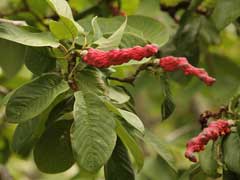 |
|
http://commons.wikimedia.org/wiki/File:Magnolia_campbellii_flowers.jpg |
 |
| http://commons.wikimedia.org/wiki/User:Mfield |
Translate this page:
Summary
Physical Characteristics

 Magnolia_campbellii is a deciduous Tree growing to 20 m (65ft) by 8 m (26ft).
Magnolia_campbellii is a deciduous Tree growing to 20 m (65ft) by 8 m (26ft).
See above for USDA hardiness. It is hardy to UK zone 8 and is frost tender. It is in flower from April to May, and the seeds ripen from July to August. The species is hermaphrodite (has both male and female organs) and is pollinated by Beetles.
Suitable for: light (sandy), medium (loamy) and heavy (clay) soils and prefers well-drained soil. Suitable pH: mildly acid and neutral soils. It can grow in semi-shade (light woodland) or no shade. It prefers moist soil. It can tolerate atmospheric pollution.
UK Hardiness Map
US Hardiness Map
Synonyms
Plant Habitats
Edible Uses
References More on Edible Uses
Medicinal Uses
Plants For A Future can not take any responsibility for any adverse effects from the use of plants. Always seek advice from a professional before using a plant medicinally.
None known
References More on Medicinal Uses
The Bookshop: Edible Plant Books
Our Latest books on Perennial Plants For Food Forests and Permaculture Gardens in paperback or digital formats.

Edible Tropical Plants
Food Forest Plants for Hotter Conditions: 250+ Plants For Tropical Food Forests & Permaculture Gardens.
More

Edible Temperate Plants
Plants for Your Food Forest: 500 Plants for Temperate Food Forests & Permaculture Gardens.
More

More Books
PFAF have eight books available in paperback and digital formats. Browse the shop for more information.
Shop Now
Other Uses
Wood - very soft. Used in construction and for making furniture[146, 272].
Special Uses
References More on Other Uses
Cultivation details
Best grown in a warm position in a moderately rich free soil of an open texture[1]. Prefers a deep rich moist acid soil[260]. Succeeds in an acid or neutral humus-rich soil in sun or part shade[184]. Tolerates an alkaline soil if it is deep and rich in humus[188]. Plants dislike dry winds[260]. The branches are brittle so a sheltered position is required[200]. Grows well in a sunny position in a woodland garden[166]. Very tolerant of atmospheric pollution[200]. Plants prefer moist summers[260]. Dormant plants are hardy to about -10°c[184], but the flower buds are often killed back by late frosts[184]. Another report says that the buds are hardy when tightly closed, but are liable to frost damage once they start to open[260]. A very ornamental plant[1]. Trees take at least 20 years from seed before they flower[166]. The fleshy roots are easily damaged and any transplanting is best done during a spell of mild moist weather in late spring[182].
References Carbon Farming Information and Carbon Sequestration Information
Temperature Converter
Type a value in the Celsius field to convert the value to Fahrenheit:
Fahrenheit:
The PFAF Bookshop
Plants For A Future have a number of books available in paperback and digital form. Book titles include Edible Plants, Edible Perennials, Edible Trees,Edible Shrubs, Woodland Gardening, and Temperate Food Forest Plants. Our new book is Food Forest Plants For Hotter Conditions (Tropical and Sub-Tropical).
Shop Now
Plant Propagation
Seed - best sown as soon as it is ripe in a cold frame. Stored seed must be kept cold over the winter and should be sown in late winter in a cold frame[200]. The seed usually germinates in the spring but it can take 18 months. Prick out the seedlings into individual pots when they are large enough to handle and grow them on in light shade in a cold frame or greenhouse for at least their first winter. They can be planted out into their permanent positions when they are more than 15cm tall, though should be well mulched and given some protection from winter cold for their first winter or two outdoors. Layering in early spring[200].
Other Names
If available other names are mentioned here
Native Range
TEMPERATE ASIA: China (Sichuan Sheng (west), Xizang Zizhiqu (southeast), Yunnan Sheng (n. & w.)) TROPICAL ASIA: Bhutan, India (Arunachal Pradesh, Manipur, Sikkim), Nepal (east), Myanmar (north)
Weed Potential
Right plant wrong place. We are currently updating this section.
Please note that a plant may be invasive in one area but may not in your area so it’s worth checking.
Conservation Status
IUCN Red List of Threatened Plants Status :

Growth: S = slow M = medium F = fast. Soil: L = light (sandy) M = medium H = heavy (clay). pH: A = acid N = neutral B = basic (alkaline). Shade: F = full shade S = semi-shade N = no shade. Moisture: D = dry M = Moist We = wet Wa = water.
Expert comment
Author
Hook.f.&Thomson.
Botanical References
11200266
Links / References
For a list of references used on this page please go here
Readers comment
| Add a comment |
|
If you have important information about this plant that may help other users please add a comment or link below. Only comments or links that are felt to be directly relevant to a plant will be included. If you think a comment/link or information contained on this page is inaccurate or misleading we would welcome your feedback at [email protected]. If you have questions about a plant please use the Forum on this website as we do not have the resources to answer questions ourselves.
* Please note: the comments by website users are not necessarily those held by PFAF and may give misleading or inaccurate information.
To leave a comment please Register or login here All comments need to be approved so will not appear immediately.
|
Subject : Magnolia_campbellii
|
|
|
|